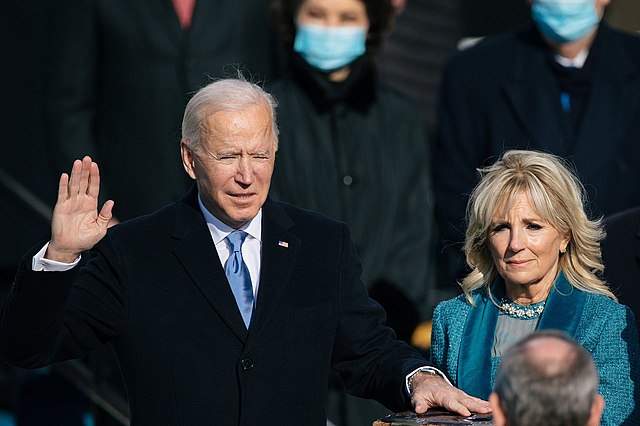The Biden presidency: One year in office
A little over a year ago, President Joe Biden rode into the White House amidst dual crises: the global pandemic and its ensuing economic downturn, plus an electoral controversy, with more than a third of Americans questioning the legitimacy of his presidency. Nevertheless, hopes were high amongst his supporters.
In his inaugural address, Biden told the American people that his inauguration marked a day of “renewal and resolve.” He promised to unite the politically divided American people and help America overcome the COVID-19 pandemic. He also swore to make America “the leading force for good in the world” again.
In the aftermath of Biden’s inauguration, we were told the “adults” were back in charge and that Biden and his advisors would quickly get COVID-19 and the economy under control. Unlike his predecessor, Biden was going to “listen to the science,” as noted in an executive order issued on his first day in office.
Polls suggested most Americans trusted Biden would stay true to these promises and that his administration would come through for us. The day after he was inaugurated, The Hill-HarrisX’s first approval rating found 63% of Americans supported him.
One year into the Biden administration, the dynamics have completely changed. It is clear Biden had a rough first year in office. Despite smug reassurances from our ruling class to the contrary, Biden has had a hard time overcoming COVID-19 and the array of other problems our nation is facing today.
Though the economy is beginning to show signs of recovery, inflation has risen to a 44-year high, the worldwide supply chain crisis has led to empty shelves around the country, and gas prices have increased from a nationwide average of $2.42 a gallon in 2020 to $3.66 a gallon as of January 2022.
It would be unfair to blame all of this on Biden – all of it is not entirely his fault, but the lack of concrete solutions to these problems has made him the face of these crises. This hasn’t stopped voters from blaming Biden.
According to a poll conducted by the Morning Consult in January 2022, 59% of voters blame Biden’s policies for rising inflation. Another poll from the Morning Consult found 62% blame Biden for supply chain issues.
The Build Back Better Framework attempted to solve some of these problems. It even had some pretty good proposals such as increasing taxes for companies for shipping jobs overseas, expanding the Earned Income Tax Credit for low-wage workers and reducing the prices of prescription drugs. However, the package was bloated, expensive and filled with Democratic priorities such as combating climate change and free universal preschool.
His approval ratings suggest that the lack of meaningful legislation and all of these crises have soured his reputation. According to RealClearPolitics, Biden currently has job approval of just 41.6% (as of Jan. 31). A poll from the Associated Press-NORC Center for Public Affairs found just 28% of Americans want him to run for reelection in 2024.
The Biden administration has proven itself unable to handle the multitude of major crises our nation finds itself in today. There is no better example of this than the stunning fall of Kabul during the withdrawal from Afghanistan.
Biden officially ended America’s longest war this past August by fully withdrawing troops from the nation. Afterward, American citizens were trapped inside the nation with no assurance when or if they would be evacuated. The White House did not even give a clear answer of how many were trapped.
Afghan allies clung to the outsides of cramped U.S. military planes in a desperate attempt to escape. Most tragically of all, 182 people (including 13 U.S. Service members) were killed in a suicide bombing at the Hamid Karzai International Airport.
Responding to the chaos that unfolded in Kabul, Biden remained firm on the decision to withdraw. Of course, getting out of Afghanistan was 100% the correct decision. We were there for far too long and should have left years ago. Getting out of the country would have always been messy. The problem came with how Biden’s administration withdrew.
The lack of responsibility taken for the violent withdrawal from Afghanistan cast a shadow of doubt and distrust on Biden’s ability to handle a major crisis. Despite repeated warnings from top military officials, Biden’s national security advisor Jake Sullivan told NBC in the days after the withdrawal that they did not anticipate the country to fall to the Taliban so quickly.
Frustratingly, this is how almost every crisis during Biden’s administration has been handled so far. COVID-19 cases are still surging despite Biden’s vaccine push, but the “adults” in charge still insist their strategy is working. Americans are struggling to put gas in their cars and manage the rising cost of food and everyday items, but Biden still contends his economic plan is working.
So far, the country has not flourished under a Biden administration. We now find ourselves in a seemingly unending cycle of crises, COVID surges and price increases. Biden has avoided taking responsibility for all of these and has yet to implement any meaningful policy solutions.
On the bright side, at least we don’t have any more mean tweets.
Your donation will support The Lion's Roar student journalists at Southeastern Louisiana University.
In addition, your contribution will allow us to cover our annual website hosting costs.
No gift is too small.

Dylan Meche is a Political Science major from Baton Rouge and serves as Opinions Editor. He has been a reporter for The Lion's Roar since August of 2019....








Abigail • Feb 3, 2022 at 10:23 am
I’d hardly call lack of mean tweets a bright side to this mess. I don’t agree with who Trump is as a person but as a politician he was a lot better than Biden has been and did a lot more for the country than people are willing to admit. All this article did was list every bad thing about Biden and an attempt to justify him as still being better than Trump as a person. We KNOW Biden is probably more morally correct than Trump. But Trump never let his morals interfere with his politics.
Brandon • Feb 1, 2022 at 10:35 am
Let’s Go Brandon!
Diogenes • Feb 1, 2022 at 2:36 pm
I’ll be happy to return to “mean tweets” for a strong America, near full employment, record personal income growth, secure boarders and draining the Swamp. “Let’s go Brandon!” should be “Get Gone Brandon”.
Jordan • Feb 1, 2022 at 4:44 pm
FJB